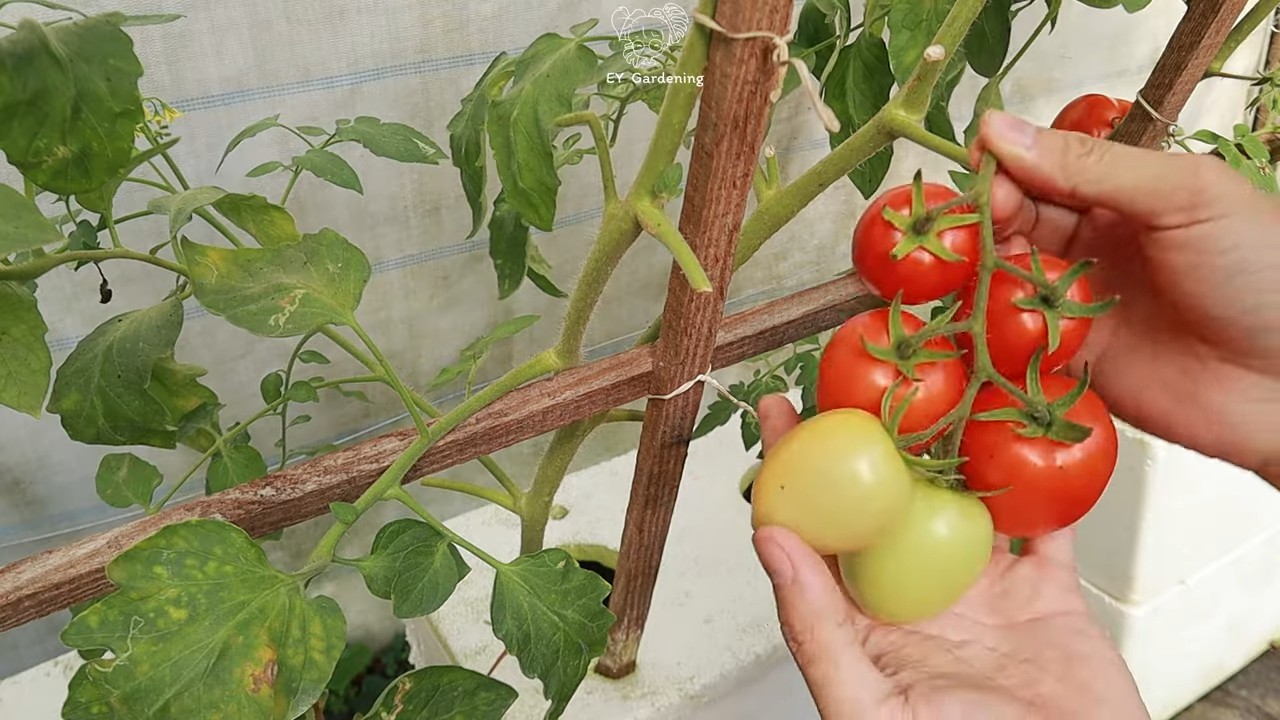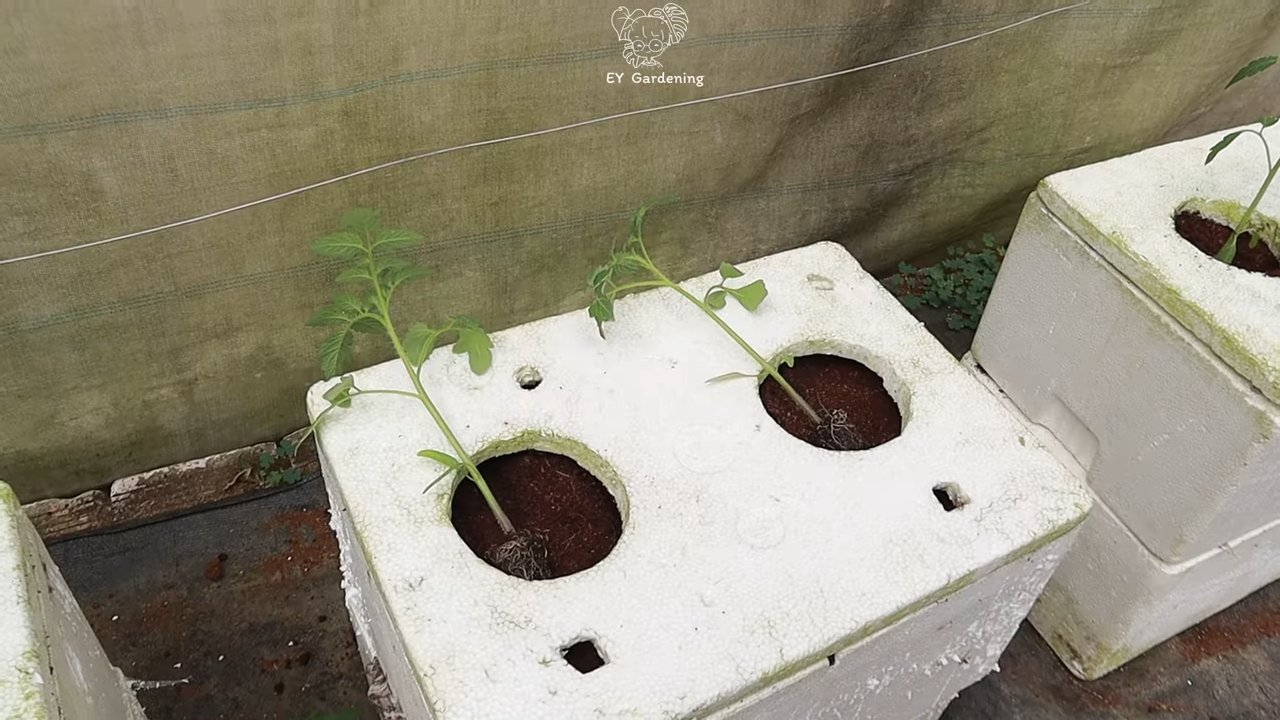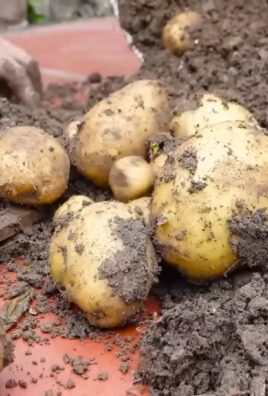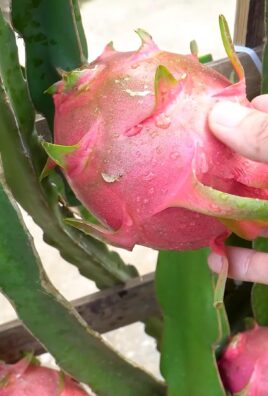Terrace tomatoes all year? Imagine stepping onto your terrace in the dead of winter and plucking a sun-ripened, juicy tomato. Sounds like a dream, right? Well, it doesn’t have to be! For centuries, gardeners have sought ways to extend the growing season, from ancient Roman greenhouses to ingenious cold frames. The desire to nurture life and enjoy fresh produce, regardless of the weather, is deeply ingrained in our human spirit.
But let’s face it, not everyone has the space or budget for a full-blown greenhouse. That’s where these clever DIY tricks come in! I’m going to share some simple, affordable, and effective methods to help you cultivate terrace tomatoes all year round. Whether you’re a seasoned gardener or just starting out, these hacks will empower you to enjoy the taste of summer, even when the snow is falling.
Why do you need these tricks? Because store-bought tomatoes in winter often lack flavor and can be expensive. Plus, there’s nothing quite like the satisfaction of growing your own food. So, get ready to transform your terrace into a thriving tomato haven, no matter the season! Let’s dive in and unlock the secrets to year-round tomato goodness.

Growing Tomatoes on Your Terrace All Year Round: A DIY Guide
Hey there, fellow gardening enthusiasts! Ever dreamt of plucking ripe, juicy tomatoes from your own terrace, even when the weather outside is frightful? Well, dream no more! I’m going to walk you through a DIY guide to growing tomatoes on your terrace all year round. It might sound ambitious, but with a little planning and effort, you can enjoy fresh tomatoes whenever you crave them.
Choosing the Right Tomato Varieties
First things first, not all tomatoes are created equal, especially when it comes to year-round terrace gardening. We need to pick varieties that are well-suited for container growing and can tolerate varying light and temperature conditions.
* Determinate vs. Indeterminate: Determinate tomatoes grow to a specific size and produce all their fruit at once, making them great for canning but less ideal for continuous harvesting. Indeterminate tomatoes, on the other hand, keep growing and producing fruit throughout the season. For year-round harvesting, we definitely want indeterminate varieties.
* Compact Varieties: Since we’re working with limited space on a terrace, look for compact or dwarf indeterminate varieties. These won’t take over your entire space and are easier to manage in containers.
* Early Maturing: Opt for varieties that mature relatively quickly (60-70 days). This will allow you to get harvests sooner and potentially squeeze in multiple crops throughout the year.
* Disease Resistance: Choose varieties that are resistant to common tomato diseases like Fusarium wilt, Verticillium wilt, and nematodes. This will save you a lot of headaches down the road.
Some excellent choices for year-round terrace tomato growing include:
* ‘Patio’ Tomato: A classic dwarf determinate variety, but still a good option for smaller spaces and early harvests.
* ‘Tiny Tim’: An ultra-compact indeterminate cherry tomato that’s perfect for hanging baskets or small containers.
* ‘Roma’: A determinate plum tomato, good for making sauces.
* ‘Early Girl’: A reliable early-maturing indeterminate variety that produces medium-sized tomatoes.
* ‘Sungold’: A popular indeterminate cherry tomato known for its exceptional sweetness.
Setting Up Your Terrace Garden
Now that we’ve chosen our tomato varieties, let’s get our terrace ready for some serious tomato action!
* Sunlight: Tomatoes need at least 6-8 hours of direct sunlight per day. Observe your terrace throughout the day to identify the sunniest spots. If you don’t have enough natural light, you might need to supplement with grow lights, especially during the winter months.
* Containers: Choose containers that are at least 12-18 inches in diameter and depth. Larger containers are better because they hold more soil and retain moisture better. Make sure your containers have drainage holes to prevent waterlogging.
* Soil: Use a high-quality potting mix that’s specifically formulated for containers. Avoid using garden soil, as it can compact and drain poorly in containers. I like to mix my own potting mix using equal parts peat moss, perlite, and compost.
* Support: Indeterminate tomato plants need support to keep them from sprawling. You can use stakes, cages, or trellises. I prefer using tomato cages because they’re easy to set up and provide good support.
* Location: Place your containers in a location that’s sheltered from strong winds. Wind can damage tomato plants and reduce fruit production.
Planting Your Tomato Seedlings
Okay, we’ve got our varieties, our terrace is prepped, now it’s time to get those little seedlings into their new homes!
1. Start Seeds Indoors (Optional): If you want to get a head start on the growing season, you can start your tomato seeds indoors 6-8 weeks before the last expected frost. Sow the seeds in seed-starting trays or small pots filled with seed-starting mix. Keep the soil moist and warm (around 70-75°F) until the seeds germinate. Once the seedlings have developed a few sets of true leaves, you can transplant them into larger pots.
2. Harden Off Seedlings: Before transplanting your seedlings outdoors, you need to harden them off. This means gradually exposing them to outdoor conditions over a period of 1-2 weeks. Start by placing the seedlings in a sheltered location for a few hours each day, gradually increasing the amount of time they spend outdoors.
3. Transplant Seedlings: Once your seedlings are hardened off, you can transplant them into your containers. Dig a hole in the potting mix that’s large enough to accommodate the root ball. Gently remove the seedling from its pot and place it in the hole. Backfill with potting mix and water thoroughly.
4. Direct Sowing (Optional): In warmer climates, you can direct sow tomato seeds directly into your containers. Sow the seeds about 1/4 inch deep and keep the soil moist until they germinate.
Caring for Your Tomato Plants
Now comes the ongoing part – nurturing your tomato plants so they thrive and give you those delicious fruits!
* Watering: Tomatoes need consistent watering, especially during hot weather. Water deeply whenever the top inch of soil feels dry to the touch. Avoid overwatering, as this can lead to root rot.
* Fertilizing: Tomatoes are heavy feeders, so you’ll need to fertilize them regularly. Use a balanced fertilizer that’s specifically formulated for tomatoes. Follow the instructions on the fertilizer label. I like to use a liquid fertilizer every 2-3 weeks.
* Pruning: Pruning is essential for indeterminate tomato plants. Remove suckers (the small shoots that grow between the main stem and the branches) to encourage the plant to focus its energy on fruit production.
* Pest and Disease Control: Keep an eye out for pests and diseases. Common tomato pests include aphids, whiteflies, and tomato hornworms. Common tomato diseases include early blight, late blight, and blossom end rot. Treat pests and diseases promptly with appropriate organic or chemical controls.
* Pollination: Tomatoes are self-pollinating, but sometimes they need a little help, especially indoors or in enclosed spaces. You can hand-pollinate your tomato plants by gently shaking the flowers or using a small brush to transfer pollen from one flower to another.
Extending the Growing Season
To grow tomatoes year-round on your terrace, you’ll need to take steps to extend the growing season, especially during the colder months.
* Cold Frames: A cold frame is a simple structure that protects plants from frost and cold temperatures. You can build your own cold frame using wood and plastic sheeting, or you can purchase a commercially made cold frame.
* Row Covers: Row covers are lightweight fabrics that are placed over plants to protect them from frost and cold temperatures. They also help to retain heat and moisture.
* Greenhouse: A greenhouse is a more permanent structure that provides a controlled environment for growing plants. If you have the space and budget, a greenhouse is a great option for year-round tomato growing.
* Grow Lights: During the winter months, you may need to supplement natural sunlight with grow lights. Use full-spectrum grow lights that provide the necessary light for plant growth.
* Heaters: If temperatures drop below freezing, you may need to use a heater to keep your tomato plants warm. Use a space heater that’s specifically designed for greenhouses or plant growing.
Harvesting Your Tomatoes
The moment we’ve all been waiting for! Harvesting your delicious, homegrown tomatoes.
* Ripeness: Tomatoes are ripe when they’re fully colored and slightly soft to the touch. The color will depend on the variety you’re growing.
* Harvesting: Gently twist or cut the tomato from the vine. Avoid pulling the tomato, as this can damage the plant.
* Storage: Store ripe tomatoes at room temperature. Avoid refrigerating them, as this can affect their flavor and texture.
Succession Planting for Continuous Harvest
To ensure a continuous supply of tomatoes throughout the year, practice succession planting. This means planting new tomato seedlings every few weeks. This way, you’ll always have plants at different stages of growth, and you’ll be able to harvest tomatoes continuously.
1. Plan Your Planting Schedule: Determine how often you want to harvest tomatoes and plan your planting schedule accordingly. For example, if you want to harvest tomatoes every week, you’ll need to plant new seedlings every week.
2. Start Seeds or Buy Seedlings: Start your tomato seeds indoors or purchase seedlings from a local nursery.
3. Transplant Regularly: Transplant your seedlings into your containers according to your planting schedule.
4. Maintain Consistent Care: Provide consistent care to all of your tomato plants, including watering, fertilizing, pruning, and pest and disease control.
Troubleshooting Common Problems
Even with the best planning, you might encounter some challenges along the way. Here are some common problems and how to address them:
* Blossom End Rot: This is caused by a calcium deficiency. Ensure consistent watering and add calcium

Conclusion
So, there you have it! Cultivating terrace tomatoes all year round might seem like a dream reserved for seasoned gardeners, but with this simple DIY trick, it’s an achievable reality for anyone, regardless of their experience level. We’ve demystified the process, breaking it down into manageable steps that empower you to take control of your tomato supply and enjoy the unparalleled taste of homegrown goodness, even when the weather outside is frightful.
This isn’t just about having fresh tomatoes; it’s about embracing a sustainable lifestyle, reducing your carbon footprint by minimizing reliance on commercially grown produce, and experiencing the sheer joy of nurturing life from a tiny seed to a vibrant, fruit-bearing plant. Imagine the satisfaction of serving a salad made with tomatoes you grew yourself, knowing exactly where they came from and what went into their cultivation. That’s a feeling that store-bought tomatoes simply can’t replicate.
But the benefits extend beyond taste and sustainability. Gardening is a therapeutic activity, proven to reduce stress and improve mental well-being. Tending to your terrace tomatoes provides a welcome escape from the daily grind, allowing you to connect with nature and find solace in the simple act of nurturing life. Plus, it’s a fantastic way to get some fresh air and sunshine, boosting your vitamin D levels and overall health.
Why is this DIY trick a must-try? Because it’s accessible, affordable, and incredibly rewarding. It transforms your terrace into a miniature oasis, providing a constant supply of delicious, homegrown tomatoes while offering a therapeutic and sustainable gardening experience. It’s a win-win situation for your taste buds, your well-being, and the environment.
Looking for ways to personalize your tomato-growing journey? Consider experimenting with different tomato varieties. Cherry tomatoes, Roma tomatoes, and beefsteak tomatoes all have unique flavors and textures, so find the ones that best suit your culinary preferences. You can also explore different growing mediums, such as hydroponics or aquaponics, for a more advanced and efficient system.
Another variation to consider is companion planting. Basil, marigolds, and onions are known to deter pests and improve the flavor of tomatoes. Planting these alongside your tomato plants can create a thriving ecosystem and enhance your harvest. Don’t be afraid to get creative and experiment with different combinations to see what works best for you.
We encourage you to embrace this DIY project and embark on your own terrace tomato adventure. Don’t be intimidated by the prospect of gardening; it’s a learning process, and every mistake is an opportunity to grow (pun intended!). Start small, be patient, and enjoy the journey.
And most importantly, we want to hear about your experiences! Share your successes, your challenges, and your tips with us and the wider community. Post photos of your thriving tomato plants, share your favorite tomato recipes, and let us know what you’ve learned along the way. Together, we can create a vibrant community of terrace tomato enthusiasts, sharing knowledge and inspiring others to embrace the joys of homegrown produce. So, grab your seeds, get your hands dirty, and let’s grow some delicious tomatoes together! Let us know how your **terrace tomatoes** are doing!
Frequently Asked Questions (FAQ)
Q: What is the best time of year to start growing terrace tomatoes using this DIY trick?
A: The ideal time to start depends on your local climate. Generally, you want to start your seeds indoors 6-8 weeks before the last expected frost. This allows the seedlings to develop a strong root system before being transplanted outdoors. If you live in a warmer climate with mild winters, you can start your seeds directly outdoors after the threat of frost has passed. However, for year-round cultivation, especially in colder climates, you’ll need to provide supplemental lighting and heating to mimic the optimal growing conditions. Consider using grow lights and a small greenhouse or cold frame to extend the growing season.
Q: What kind of soil is best for growing terrace tomatoes?
A: Tomatoes thrive in well-draining, nutrient-rich soil. A good potting mix specifically formulated for vegetables is a great starting point. You can also amend your soil with compost, aged manure, or other organic matter to improve its fertility and drainage. Avoid using garden soil directly in containers, as it can become compacted and restrict root growth. The ideal pH for tomato soil is between 6.0 and 6.8. You can test your soil’s pH using a soil testing kit and adjust it accordingly with lime (to raise pH) or sulfur (to lower pH).
Q: How much sunlight do terrace tomatoes need?
A: Tomatoes are sun-loving plants and require at least 6-8 hours of direct sunlight per day to thrive. If your terrace doesn’t receive enough natural sunlight, you’ll need to supplement with grow lights. LED grow lights are a great option, as they are energy-efficient and provide the full spectrum of light that tomatoes need for optimal growth. Position the grow lights close to the plants, but not so close that they burn the leaves. Adjust the height of the lights as the plants grow to ensure they are always receiving adequate light.
Q: How often should I water my terrace tomatoes?
A: The watering frequency depends on several factors, including the weather, the size of the container, and the type of soil. Generally, you should water your tomatoes deeply whenever the top inch of soil feels dry to the touch. Avoid overwatering, as this can lead to root rot. During hot, dry weather, you may need to water your tomatoes daily. In cooler weather, you may only need to water them every few days. Use a watering can or a hose with a gentle spray nozzle to avoid damaging the plants.
Q: What are some common pests and diseases that affect terrace tomatoes, and how can I prevent them?
A: Common pests that affect tomatoes include aphids, whiteflies, tomato hornworms, and spider mites. Common diseases include early blight, late blight, and blossom end rot. To prevent pests and diseases, start by using disease-resistant tomato varieties. Practice good sanitation by removing any dead or diseased leaves and debris from around the plants. Use organic pest control methods, such as insecticidal soap or neem oil, to control pests. Ensure proper air circulation around the plants to prevent fungal diseases. Blossom end rot is caused by a calcium deficiency, so make sure your soil is rich in calcium and that you are watering your plants consistently.
Q: How do I know when my terrace tomatoes are ripe?
A: The color of the tomato will change from green to its mature color (red, yellow, orange, etc.), depending on the variety. The tomato should also feel slightly soft to the touch. Gently squeeze the tomato; if it gives slightly, it’s ripe. The aroma of the tomato will also become more pronounced as it ripens. Avoid picking tomatoes that are still hard or green, as they will not ripen properly off the vine.
Q: Can I grow terrace tomatoes in hanging baskets?
A: Yes, you can grow certain varieties of tomatoes in hanging baskets. Choose compact or dwarf varieties that are specifically bred for container gardening. Cherry tomatoes and grape tomatoes are particularly well-suited for hanging baskets. Make sure the hanging basket is large enough to accommodate the plant’s root system and that it has good drainage. Use a lightweight potting mix and water the plants regularly, as hanging baskets tend to dry out quickly.
Q: How do I prune my terrace tomatoes?
A: Pruning tomatoes can improve air circulation, promote fruit production, and prevent diseases. Remove any suckers (small shoots that grow between the main stem and the branches) that appear below the first flower cluster. These suckers will not produce fruit and will only drain energy from the plant. You can also remove any yellowing or diseased leaves. Use clean, sharp pruning shears to avoid spreading diseases.
Q: What kind of fertilizer should I use for my terrace tomatoes?
A: Tomatoes are heavy feeders and require regular fertilization. Use a balanced fertilizer that is specifically formulated for tomatoes or vegetables. Look for a fertilizer with an NPK ratio (nitrogen, phosphorus, potassium) of around 5-10-5 or 10-10-10. Fertilize your tomatoes every 2-3 weeks, following the instructions on the fertilizer package. You can also supplement with organic fertilizers, such as compost tea or fish emulsion.
Q: How can I overwinter my terrace tomato plants?
A: While tomatoes are typically grown as annuals, you can try to overwinter them in warmer climates or by bringing them indoors. Before the first frost, prune the plants back significantly and transplant them into smaller pots. Place the pots in a sunny location indoors and provide supplemental lighting if necessary. Water the plants sparingly and fertilize them lightly. The plants may not produce fruit during the winter, but they will be ready to start growing again in the spring.





Leave a Comment